#hans grimm
Explore tagged Tumblr posts
Text
Dec.21.22

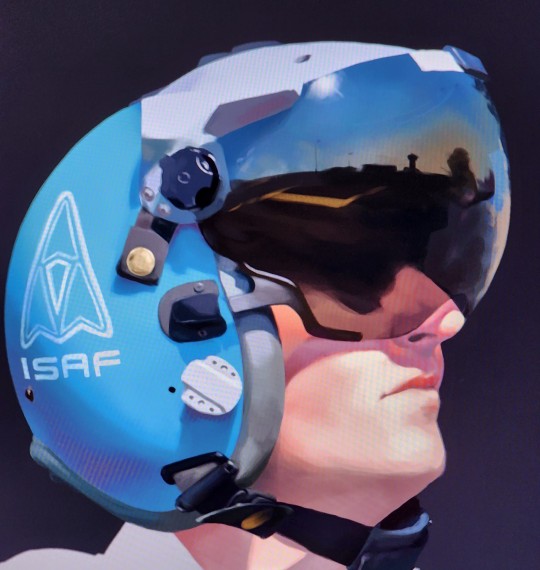






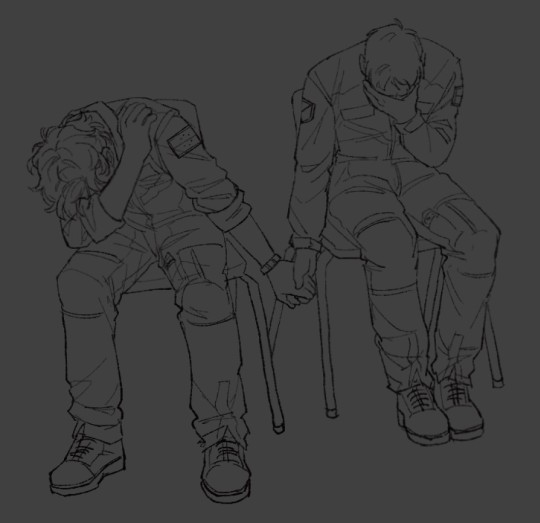
#fanart#digital art#ace combat#ace combat 4#ace combat zero#ace combat 5#wardog#mobius 1#awacs skyeye#blaze#kei nagase#hans grimm#chopper
60 notes
·
View notes
Text


Arts & Crafts with Leaf
#black souls#black souls 2#blacksouls#Hans christian Andersen#Lewis Carroll#Grimm Brothers#Grimm#Leaf
127 notes
·
View notes
Text
Tanbi to Heroine - Literary classics adapted into shoujo manga
I want to talk about the book of my dreams: Mangaka! Sekai Bungaku - Tanbi to Heroine (マンガ化! 世界文学 耽美とヒロイン). It's a compilation of shoujo manga from the 1970s and 1980s which are adaptations of classics from world literature. Each manga has a little introduction about its artist, and the work it was adapted from. Thank you, our Tosho no Ie overlords.

It came out in 2022, and I'm so happy to own this book. After watching Aoi Bungaku and falling in love with what they did with Kokoro there, I've always wanted to see more anime/manga adaptations of literature. Seeing how authors/directors give the works their own interpretations while still staying faithful to the original work, and not trying to do a 1:1 adaptation can be great, as long as they don't jump the shark. Speaking of which, I even liked Gankutsuou despite the bizarre 3D space mecha fights because Edmond Dantès was still there. I can't get mad at it when the director gets the core of the work right.
Anyway, I want to present this awesome book and the manga collected in this volume!
Hagio Moto – Shiroi Tori ni Natta Shoujo (白い鳥になった少女)

Adapted from Andersen's The Girl Who Trod on A Loaf, and first published in Bessatsu Shoujo Comic 1972/12.
Hagio tells the story from the point of view of the girl who becomes a bird at the end of the tale, which is a very nice touch.
2. Mizuno Hideko – Cendrillon (サンドリヨン)
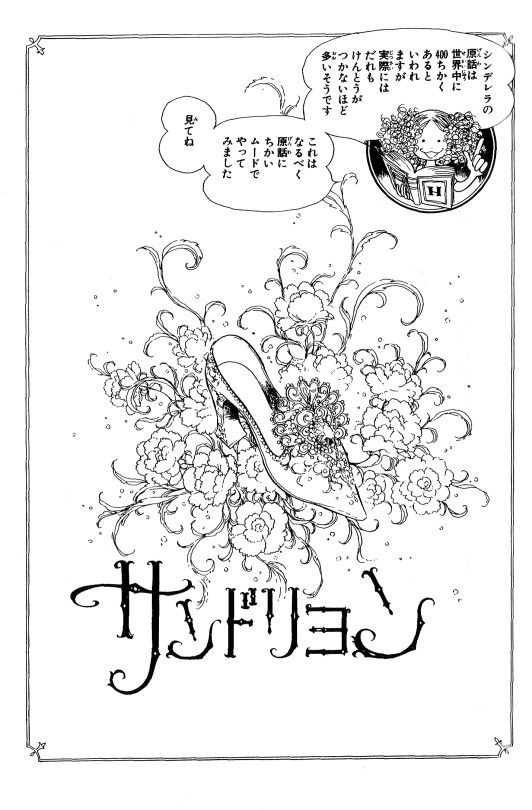
Adapted from Grimm Brothers' Cinderella, and first published in LaLa 1977/9 & 11.
With Mizuno's exquisite art, this Cinderella adaptation is the perfect fairy tale. On the first and last pages Hideko-tan breaks the fourth wall to give us information about the original work, and going "bruh, these are supposed to be tales for kids but some brutal stuff goes on in them. What's with all the mutilations and eye-gouging?!" It's adorable!
3. Maki Miyako – Hanakagerou (花陽炎)

Adapted from Murasaki Shikibu's The Tale of Genji, and first published in Big Comic for Lady 1987/2.
This excerpt is taken from vol. 2 of Maki's Genji Monogatari adaptation, and depicts a scene that doesn't exist in the original work: Hikaru meeting Lady Fujitsubo for the first time. I must say that all that Genji Monogatari Japanese went over my head ;_;
4. Miuchi Suzue – Takekurabe (たけくらべ)
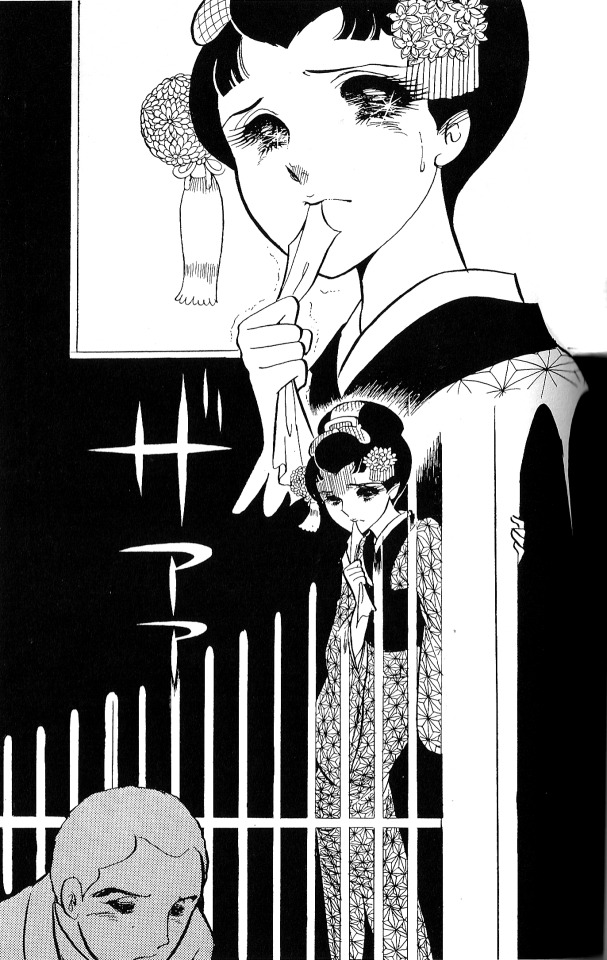
Adapted From Higuchi Ichiyou's Takekurabe, and first published in Hana to Yume 1977/1 & 2. This story is actually part of Miuchi's Glass Mask. In the manga, it was acted in the third act, “Kaze no Naka wo Iku.” Compiled in vol.s 3-4 Hana to Yume comics version, vol.s 2-3 of Hakusensha Bunko, and vol.s 3-4 of the digital ebook.
Conveying the subtleties of the character through the way Ayumi and Maya acts is quite ingenious. We get adaptation-ception with this one, and I loved it. It really made me want to read the book to get to know Midori better.
5. Sakata Keiko – Okisaki to Nemuri Hime (お妃と眠り姫)

Adapted from Charles Perrault's Sleeping Beauty, and first published in Comic Tom 1989/1.
I haven't read Sakata's works, but she always strikes me as being the odd one in the shoujo scene. And this manga just strengthened my conviction. Her adaptation of Sleeping Beauty focuses on the ogre mother of the Prince, and her loneliness. Which is another ingenious way of going about adapting a fairy tale from a completely point of view. Her funny-looking art and humor adds to it.
6. Fumizuki Kyouko – Shiroki Mori no Chi ni (白き森の地に)
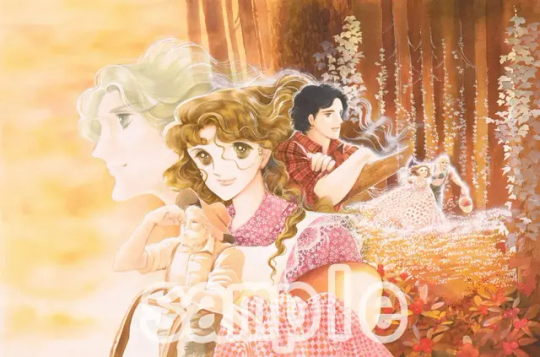
You get this color image I found online, because scanning this gorgeous double spread was impossible. And it's in grayscale in the book.
Adapted from Louis Hémon's Maria Chapdelaine, and first published in Bessatsu Shoujo Friend 1977/3.
I had no idea about this story, but wow, Hémon sure lived a life... This story that takes place in Canada feels really comforting. I'm surprised this didn't get an anime adaptation. Sure, it's not long enough for one, but it'd make a perfect comfort shoujo. "Comfort shoujo" as in people dying and the protagonist growing up after being hit by misery and having to make life-altering choices. I can see why this was popular in Japan.
7. Yamagishi Ryouko – Rapunzel Rapunzel (ラプンツェル・ラプンツェル)

Feast your eyes on this color Rapunzel illustration from the Yamagishi artbook I have.
Adapted from Grimm Brothers's Rapunzel, and first published in Bessatsu Shoujo Friend 1974/6.
Queen Yamagishi does not disappoint: We go full psychological and read about how parents ruin childrens' lives by projecting their shortcomings in life onto them, and their twisted sense of "love" can be worse than a sorceress's curse. Prince charming therapy time, baby!
8. Sato Shio – Bijo to Yajuu (美女と野獣)

Adapted from Madame de Beumont's Beauty and the Beast, and first published in Papermoon Shoujo Manga Fantasy Shoujo Manga – 1001 Nights (5.11.1980).
This short yet poignant adaptation really brings out the love in the story. She distilled the tale, and left what touches your heart the most in these 8 pages.
This work was also originally published in full color, and it's so gorgeous that I bought the book it was first published in. I hope to have it within the month.
So yeah, if you need to gift something to your old-shoujo loving friend, you now know what to get :)
#萩尾望都#hagio moto#hans christian andersen#水野英子#mizuno hideko#cinderella#grimm brothers#牧美也子#genji monogatari#maki miyako#the tale of genji#美内すずえ#miuchi suzue#glass mask#glass no kamen#takekurabe#higuchi ichiyo#坂田靖子#sakata keiko#charles perrault#sleeping beauty#文月今日子#fumizuki kyouko#louis hémon#maria chapdelaine#山岸凉子#yamagishi ryouko#rapunzel#佐藤史生#sato shio
56 notes
·
View notes
Text
back by popular demand (3 people are interested :D)
classic lit authors and what abilities I think they should have
(I have a very clear preference for psychological abilities)
-abilities can be based on the plot, themes, or just the title itself. not gonna clarify which it is, but it should be self explanatory enough
Jane Austin -- Pride and Prejudice -- cupid-esque, makes people fall in love.
John Knowles -- A Separate Peace -- reads people's emotions. cannot do anything useful with the info he gets from this.
Charles Dickens -- Great Expectations -- midas-esque, turns what he touches into gold. (I think it would be cool if he could also turn things into liquid gold, which can harden to trap a target. however iirc gold is not very strong so... but also it's magic so anything can happen)
Miguel de Cervantes -- Don Quixote -- tells one lie a day that one listener (intended target) will believe. It wears off the following day. Third parties are not predisposed to believe the lie.
Edith Wharton -- The Age of Innocence -- temporarily removes all ill-intent from a target. ALL includes both intent towards her and towards anyone else.
Ray Bradbury -- Fahrenheit 451 -- literally just fire. classic elemental fire ability.
Willa Cather -- My Antonia -- one way telepathy: can talk directly into people's minds but cannot receive mental messages back. this is entirely because I hated this book so much that I wished it could just be zapped into my brain so I wouldn't have to torture myself by reading it.
George Bernard Shaw -- Pygmalion -- medusa-esque, turns people to stone through eye contact
Homer -- The Odyssey -- basically geoguesser. teleports people into a random location anywhere in the world. cannot choose where he's sending them. (all I'm imagining is him trying to use it in a fight and the person teleports like 2 inches to the left. then punches him.)
Sophocles -- Oedipus Rex -- gives people random personalized prophecies. never makes sense until after it's fulfilled.
Eugene O'Neil -- Long Day's Journey into Night -- I'd like to imagine this guy's got that 'illness personified' aesthetic. the ability should be something to do with disease and decay. but I care more about the visual portrayal of the character as something physically rotting. (visually distinct character design my beloved <3)
Baroness Emma Orczy -- The Scarlet Pimpernel -- shapeshifter. I've posted about her on my main too,, I really think bsd could use a shapeshifter. That's a much more grounded sort of chaos that could lead to higher stakes situations without this whole "world ending vampires whatever fyodor's got going on."
-in all seriousness I think if Asagiri would make use of more psychological abilities or psychological threats he could have as many high stakes stories as he wants without power scaling/power creep. but that would involve writing actual mysteries in the detective story. so.-
-I'm so sorry asagiri :( -
Franz Kafka -- The Metamorphosis -- turns into a bug. same way Natsume turns into a cat.
Alexandre Dumas -- The Count of Monte Cristo -- deflects attacks. Any attack that hits him inflicts that damage onto the attacker instead.
Lewis Carroll -- Alice in Wonderland -- shrinks and grows things (including himself).
William Golding -- Lord of the Flies -- causes conflict among groups. I'd like to think the mechanics of it could be interesting-- like it shows him different dialogue options [video game style!], indicating which line would cause the most conflict.
There would often be no context for why that line would cause conflict, and he has no way of knowing if the conflict will be directed at him, or just within the group as a whole. He can choose a more harmless option, or he could risk it on the big conflict option in an attempt to eliminate enemies.
George Orwell -- 1984 -- spies on set target, like a camera trained on one person. can only spy on one person at a time.
Harper Lee -- To Kill a Mockingbird -- frames a target for a crime. the reverse of Mushitaro's-- generates fake evidence for a crimes instead of removing real evidence.
Oscar Wild -- The Picture of Dorian Gray -- essentially immortality so long as one designated item doesn't get destroyed.
Niccolò Machiavelli -- The Prince -- influences targets. not strong enough to truly be considered mind control, but fairly strong persuasion. see my The Prince post where I explain so much in the tags.
Antoine de Saint-Exupéry -- The Little Prince -- allows him to understand people. thoroughly. please please go see my the prince/the little prince post, I explain so much in the tags. I have so many thoughts about these two.
Robert Louis Stevenson -- Strange Case of Dr Jekyll and Mr Hyde -- compels people to act on their temptations and impulses. cannot convince people to do things they would have no desire to do otherwise.
Victor Hugo -- Les Miserables -- I think it would be very funny if it just made them unrecognizable to law enforcement. not shapeshifting, just all cops cannot recognize this guy's face. (they could recognize his muscles though, as per lore accurate les mis.)
William Shakespeare -- To Be or Not To Be (I am not naming this Hamlet. strictly for vibes.) -- gives people existential crises. If they have existential crises regularly already, it doesn't do anything.
I'd like to imagine he'd use it on a character who usually comes across as relatively well adjusted and. nothing happens. Like if atsushi/kunikida/chuuya were to be targeted they'd just be like "yeah idk nothing happened... sorry man. better luck next time."
Issac Asimov -- The Feeling of Power -- ability allows him to do any math- no matter how difficult or complex- without a calculator. I'd like to think he's insist that he doesn't have an ability, he's just really good at math. basically the opposite of ranpo.
Reginald Rose -- Twelve Angry Men -- the antithesis to Harper Lee, finds evidence proving anyone innocent. or at least can prove plausible deniability.
Arthur Conan Doyle -- Sherlock Holmes -- understand in full what anyone's ability is, and what its limits, strengths and weaknesses are.
we don't have enough ability-related abilities in bsd. too much offense and defense, not enough middle ground stuff.
Tennessee Williams -- The Glass Menagerie -- turns people into 'glass', or drastically decreases their durability. doesn't harm the target in and of itself, but the target needs to leave any combat because now they can be killed in one hit.
Arthur Miller -- Death of a Salesman -- communicates with the dead. We're gonna need something like this if Asagiri keeps killing off characters at the rate he's currently going.
#ngl I wanted to do more but I didn't want to force myself to list every author I could think of#with no decent ideas of abilities for them to have#anyone wanna give abilities to hans christian anderson and the grimm brothers?#because there's definitely a lot of material to work with#anyway not gonna tag any of these authors or works because I know classic lit tumblr doesn't want this in their tags#I certainly don't#pleaseeeee give this attention#y'all asked for this and I delivered#bsd#bungo stray dogs#bungou stray dogs#kafka asagiri#an absolute unreasonable amount of effort went into this
41 notes
·
View notes
Text
Diamonds, Toads, and Dark Magical Girls
According to Bill Ellis in "The Fairy-Telling Craft of Princess Tutu: Meta-Commentary and the Folkloresque," the fairy tale of Cinderella can be seen as one of the earliest examples of the transformation sequences/henshin seen in magical girl anime, particularly in how the title character is given items that help her achieve a goal, usually given to her by a magical being (her mother's spirit in a tree, a fairy godmother, etc.).
Thinking again about the connection between magical girls and fairy tales--even if they aren't as meta as Tutu, many magical girls do use imagery and ideas from European fairy tales (Sailor Moon alone has references to Hans Christian Andersen and Charles Perrault)--I wondered what other character types from the genre may have some precedent in fairy tales. Then I started thinking about the Dark Magical Girl character.
Not every magical girl story has a Dark Magical Girl, but they do crop up in a lot of works. To name a few, there's Fate Testarossa from Magical Girl Lyrical Nanoha, Homura Akemi from Puella Magi Madoka Magica, Rue/Kraehe from Princess Tutu, and countless others that would be too numerous to name. In general they tend to be more cynical, darker counterparts to the main protagonists, who tend to come from relatively more stable environments. Whatever magic they possess also may be more sinister, at least initially.
Tying in somewhat to the story of Cinderella is the Aarne-Thompson-Uther Index fairy tale type "The Kind and Unkind Girls" (ATU 480). Many of the stories of this type involve a rivalry between two stepsisters, one being favored by the stepmother due to being the latter's biological daughter. The general idea in most versions of the tale is that both girls encounter a magical being at separate points in time. The kind girl helps the magical being in some way, at which point the magical being gives her a magical ability or magical presents. Meanwhile, the unkind girl refuses to help the magical being and is cursed in some fashion, or, worse, killed. The kind girl meanwhile usually ends up marrying a prince, or a similar character. One of the more popular versions of this story, "Diamonds and Toads," has the kind girl gain the ability to have a jewel or flower fall from her mouth when she speaks, while the unkind girl is cursed to have toads and snakes fall from hers. And while the kind girl does marry a prince, the unkind one is kicked out of her house and dies alone in the woods. (Insert something about Revolutionary Girl Utena's comment about how a girl who cannot become a princess is doomed to be a witch.)
Typically in these fairy tales, the unkind girl is never shown to be a real threat to the kind one; the ultimate threat is the stepmother, who uses her daughter as a means to an end. In contrast, Dark Magical Girls tend to have, well, magic that helps them attack the magical girl protagonist. In this regard, they're the Heavy in the plot, while the witch/mother-like figure/real enemy waits in the background (as is the case in a lot of magical girl shows--the Raven and Rue, Precia and Fate, Fine and Chris in Symphogear etc.). Sometimes the Dark Magical Girl will be a major threat, though--like the Princess of Disaster in Pretear (who is loosely-inspired by the Evil Queen in Snow White).
In The Uses of Enchantment: The Meaning and Importance of Fairy Tales (1976), Bruno Bettelheim argues that the stepmother as a character is a way for children to process the negative traits of their own mothers, while still idealizing the good qualities of them. With that in mind, the unkind sister and the Dark Magical Girl can be viewed as a way of processing/externalizing the negative traits that a girl can have, being cruel, rebellious, and uncaring. They also embody their fears, too--the fear of being alone, rejected, and doomed to fail.
Of course, nowadays, Dark Magical Girls have a tendency to be redeemed and reconcile with/befriend the main magical girl, something the kind and unkind girls never seem to do in the fairy tales. Maybe it's just emblematic of society deciding that killing a girl off for being a little rude is a bit unfair. She's just a kid trying to find her place in the world, too, after all.
#magical girl#magical girl lyrical nanoha#puella magi madoka magica#princess tutu#senki zesshou symphogear#dark magical girl#fate testarossa#homura akemi#rue kuroha#princess kraehe#chris yukine#cinderella#diamonds and toads#kind and unkind girls#fairy tales#hans christian andersen#brothers grimm#charles perrault#bruno bettelheim#the uses of enchantment#random thoughts#text#read more
114 notes
·
View notes
Text
Books That Are Fairytale Retellings

The Sleeper and The Spindle by Neil Gaiman
A Court Of Thorns and Roses by Sarah J. Maal
Cinderella Is Dead by Kalynn Bayron
The Girl In Red by Christina Henry
Once Upon A Time: A Story Collection by Shannon Hale
Lost In The Never Woods by Aiden Thomas
The True Story Of Hansel and Gretel by Louise Murphy
Cinder by Marissa Meyer
The Big Over Easy by Jasper Fforde
The Mermaid by Christina Henry
House Of Salt and Sorrows by Erin A. Craig
Girls Made Of Snow And Glass by Melissa Bashardoust
The Storybook of Legends by Shannon Hale
The Wishing Spell by Chris Colfer
Forest Of A Thousand Lanterns by Julie C. Dao
Geekerella by Ashley Poston
The Fourth Bear by Jasper Fforde
Gingerbread by Helen Oyeyemi
To Kill A Kingdom by Alexandra Christo
Six Crimson Cranes by Elizabeth Lim
Once Upon A Broken Heart by Stephanie Garber
#fairytale#fairytale retelling#the brothers grimm#ever after high#books#book blog#booklr#readblr#book reccs#book recommendations#bookaddict#book list#fairytale book list#fairytale books#hans christian andersen#the little mermaid#little red riding hood#nursery crimes#beauty and the beast#hansel and gretel#cinderella#snow white#bookworm#books and reading
352 notes
·
View notes
Text

Anne Anderson (1874-1952), ''Grimms' & Andersen's Fairy Tales'', 1912 Source
#anne anderson#scottish artists#scottish illustrators#the brothers grimm#hans christian andersen#vintage illustration#vintage art#children's books#fairy tales
155 notes
·
View notes
Text








Marvel please give us a big event where all these super cool heroes mixed up in magic and the supernatural can meet!
#betsy braddock#captain britain#wanda maximoff#scarlet witch#white fox#ami han#bloodline#brielle brooks#clea#else bloodstone#marvel#marvel comics#x-men#avengers#agents of atlas#midnight sons#pixie#megan gwynn#nico minoru#sister grimm
33 notes
·
View notes
Text









Snow White and the Huntsman (2012) has me thinking Rupert Sanders is a fan of Ico.
I like being able to see both The Brothers Grimm (Snow White) and Hans Christian Andersen (The Shepherdess and the Chimney Sweep via The King and the Mockingbird) in Ico.
#snow white and the huntsman#rupert sanders#ico#shadow of the colossus#fumito ueda#brothers grimm#hans christian andersen#the shepherdess and the chimney sweep#the king and the mockingbird#le roi et l'oiseau#shadow creatures#troll#chris hemsworth#charlize theron
18 notes
·
View notes
Text

Get ready to dive into a world of magic!! Erstwhile Fairy Tales is coming to Webtoons!
Created by Gina Biggs, Louisa Roy, and Elle Skinner, this anthology series adapts Grimm's Fairy Tales beautifully illustrated comics!
Subscribe now!
#webcomic#romance#comics#fantasy#fairy tales#grimms fairy tales#brothers grimm#snow white and rose red#big bad wolf#iron hans#all fur#magic
37 notes
·
View notes
Text
Dungeon meshi has wonderful and thought out world building but the inherent creator bias still shows through sometimes in small funny ways
#dungeon meshi#ep 1#why are they eating with chopsticks when the island is mostly western in architecture/culture etc#hahaha#i always think its so funny even in like medieval isekais/webtoons#when everyone has european names#castles#dresses etc#but their school system is japanese or their meals etc#like the small stuff the author thinks is normal#calling the duke 'hyung' when there is absolutely no way that would happened at that time#its a bit endearing#i read a brothers grimm/fairy tale inspired manga#and the protag is a grimm brother who befriends hans christian andersen and subsequently calls him “an-chan”#western media has that a lot too#people eating with forks when they would use chopsticks#having meals with beef in them when its a terrain where cows wouldnt live and chicken or goat or fish would make more sense#eastern media aallllwaaysss including an age based honorifics system#western media often modeling religion along the abrahamic faiths#etc
27 notes
·
View notes
Text
Comparing fairy tales with their inspirations from legendary sagas produces a weird effect, because you can see where the stories have been simplified and the behavior of the protagonists sanitized.
The Goose Girl whose position was stolen by her handmaiden and was reduced to speaking to her beheaded horse Falada was a club-footed princess who originally agreed to switch places with her maid because she was self-conscious about her feet and feared her prince was short and ugly. She was also mother of Charlemagne.
The Goose Girl at the Well who was exiled for saying she loved her father like meat loves salt was a British queen who led an army to rescue her father who had been driven insane by her abusive sisters.
Sleeping Beauty, who was cursed to sleep for a hundred years, was a Valkyrie who masterminded the death of her prince when he was brainwashed into marrying another woman, and then threw herself onto his pyre so she could die with him.
The youngest brother of the Wild Swans, whose arm remained a swan wing because his sister ran out of thread to make the tunic that would break his curse, became a knight in a swan boat that avenged a noble maiden's honor and had children with her that would give rise to the royal line of Bouillon.
Cinderella was a successful courtesan and a self-made woman, who had no fairy god mother, but did have a fling with fable-teller Aesop as well as an epic rivalry with her sister-in-law, who happened to be one of the greatest poets of their age. Alternatively, she was a queen of Egypt to died before seeing her family enslaved by the mad Persian king Cambyses.
The mystical husbands of East of the Sun and West of the Moon, The Iron Stove, and the Feather of Finist the Falcon were originally the god Eros, and the Beauty that had to find her husband after losing him was his wife Psyche.
Often the animal husband takes the form of a snake. In certain myths among the indigenous Taiwanese, the animal husband is a snake and the ancestor of their people. In Baltic and Slavic stories, the snake husband is never accepted by his wife's family, who kill him through deceit. Meanwhile, a 9th century Chinese story makes the husband into a Yaksha, and the lovers are eventually parted because the wife cannot stay in the realm of the Yaksha.
Related to the animal husband theme, the Beast was a tragic man from Tenerife with hypertrichosis, and Beauty was a noblewoman who was married to him almost as a joke. Though they lived a long and happy life together, four of their seven children were stolen away and sent to live in foreign courts because they shared their father's condition.
The Girl Without Hands was a Mercian queen who ruled her nation with iron fists, and was involved in more than one assassination.
Maid Maleen's original name was Brangaine, the maid of Tristan and Iseult. In most variants of the tale, it is the guilty bride who substitutes her maid in the bridal procession to hide her loss of virginity that is the actual protagonist. When the prince questions her about the children she has born, she is forced to reveal the tokens that her lover left with her, and the prince realizes that he himself is the lover in question, and apologizes and proceeds with the wedding.
The speechless Little Mermaid's beloved prince was a Swedish duke, brother to the king, named Magnus Vasa. He was afflicted with psychotic episodes throughout his life, and had assistants assigned to look after him. He never married but had a longtime affair with a commoner woman who cared for him. During one of his episodes, he jumped into a moat, claiming to have seen a woman there. This became the basis for a class of ballads called Herr Magnus and the Mermaid, which describes how Magnus lost his heart and then his mind to the mermaid after initially rejecting her. This then became stories of the tragic mermaid's rejection and revenge.
#mythology#history#fairy tale#little mermaid#sleeping beauty#cinderella#beauty and the beast#the goose girl#king lear#brothers grimm#hans christian andersen
31 notes
·
View notes
Text
I really need everyone to see Hans from Jim Henson's The Storyteller episode "Hans my Hedgehog"


#the video quality is terrible but this man haunts my dreams#WHY DOES HE STAND LIKE THAT#HE LOOKS LIKE AN AWKWARD TEENAGE BOY TRYING TO HANG OUT WITH THE COOL KIDS#hans my hedgehog#grimm fairy tales#brothers grimm#fairy tales#fairytales#jim henson#the storyteller
30 notes
·
View notes
Text
Do you think Hans Christian Anderson and the Grimm brothers knew that they were creating iconic stories or was it just work for them?
17 notes
·
View notes
Text
I love stories.
The undying amount of possibilities for our imagination which they offer.
When I was a child, I always ran around the forests, looking for a rabbit hole to Wonderland. As I never found one, I tried wardrobes, hoping I could get into Narnia. Every night, I left my window open, waiting for Peter Pan to take me to Neverland. When I found an old carpet in the attic, I was persuaded it was Aladdin's and I tried to talk it into taking me to see the pyramids several times. It hasn’t moved yet.
Then, once I've read the Spiderwick Chronicles, I realized I should stop just waiting for a letter from Hogwards. It's better to pay attention, see what is around - and act, if necessary.
I started collecting weird stones in hopes they could turn into a Waterhorse and when it didn't work, I got myself a dragon egg (I've spent hours wrapping the crumpled newspaper with ceramics and meticulously painting the round thing after it dried, but it was worth it: the dragon is still waiting for the right time to hatch.). Apart from being a dragon rider as Eragon, I was also a discoverer, just as Spiderwick: I wrote and illustrated my own book of fairy creatures just to be able to turn its pages and feel like the magic was breathing at me. I stole a pair of beans in the kitchen and with a beating heart, I planted them under my bed, believing they would once take me to the realm of giants (this only didn’t work because I forgot to water the poor beans and wasted my only opportunity to meet Jack). I secretely stole my grandma's ring with a blue stone and tested a turn as Arabela did it to make my wishes come true (I cracked the trick – if you ask for the night to come at the end of the day, it always comes true...) and I only returned the ring once I got a goldfish. I also was very good in making potions out of pickled chestnuts - it was just that no-one ever wanted to try them (my dad told me he didn't really want to turn into a cat, but maybe it was the taste, because when I forced a spoon into my brother's mouth, he spat it out).
As you probably grasped, I am the type of person who prefers silver over gold because when I was younger, it had a meaning. Someone who doesn’t really want to know how the trick is done, for I enjoy the spell of not knowing. And even if in some cases, I couldn't really shield myself, I could never ruin it for others. Because Santa Claus is real as long as you put cookies and milk to the window for him.

Samodivas dancing in ‘Le Villi’ (1906) by Bartolomeo Giuliano
#stories#storytime#magic#fairy tales#fairies#peter pan#alice in wonderland#finding neverland#jack and the beanstalk#arabela#witches#brothers grimm#hans christian andersen#folklore#mythology and folklore#loch ness monster#potions#wizard#santa claus#the spiderwick chronicles#alexander pushkin#goldfish#aladdin#narnia#chronicles of narnia#water horse#dragons#eragon#christmas#elves
12 notes
·
View notes
Text



Brave (2012, Mark Andrews, Brenda Chapman, Steve Purcell)
30/05/2024
#Brave#animation#2012#mark andrews#Brenda Chapman#steve purcell#List of Pixar films#pixar#85th Academy Awards#Academy Award for Best Animated Feature#brad bird#orson welles#john lasseter#bow and arrow#arrow#Bear#shire horse#tapestry#witch#menhir#merida#Twin#brothers grimm#hans christian andersen#julie walters#billy connolly#emma thompson#craig ferguson#robbie coltrane#john ratzenberger
8 notes
·
View notes